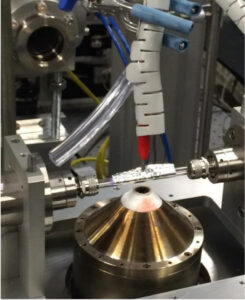Energy Theme highlights: Probing the role of a non-thermal plasma (NTP) in the hybrid NTP-catalytic oxidation of CH4

The release of methane into the atmosphere must be stringently controlled as it has a warming potential at least 21 times higher than that of CO2, being, therefore, a major contributor to climate change. The methane slip in automotive vehicles could be address by using an efficient catalyst capable of completely oxidising CH4 to CO2 and H2O under cold start conditions. Although palladium is a known efficient catalyst for methane oxidation, it requires light-off temperatures above 300°C. The coupling of non-thermal plasmas (NTPs) with catalysis can be used to overcome the kinetic limitations but despite the efficacy of NTPs, their mode of operation remains unknown as to date, there are very few in situ studies to characterise these hybrid plasma-catalyst systems.
The research started on the premises that there are mainly three hypotheses to explain the combined effect of NTP and catalysts: heating, modification of the catalyst or the ability of plasma to produce species that can open up new reaction pathways. Therefore, we have decided to investigate the plasma-assisted CH4 oxidation over a Pd/Al2O3 catalyst on the B18 beamline at Diamond. This allowed us to probe the structure and oxidation state of the Pd nanoparticle by X-ray absorption fine structure (XAFS), while constantly monitoring the reaction products by end of pipe mass spectrometry.
This in situ study has shown that the temperature of the Pd nanoparticle increased under plasma exposure but to values far below the ones required to activate the thermal CH4 oxidation reaction. Furthermore, no significant structural changes of the catalyst were detected under NTP conditions. Therefore, the most likely hypothesis to explain the observed synergy of in-plasma catalyst systems is the occurrence of an alternative methane activation pathway, through a lower activation barrier than the thermal activation reactions. This alternative pathway is proposed to be the activation of methane in the gas phase involving the formation of CH3(g) via electron impact reactions, leading to a reduced activation barrier for the surface process.
The team is now investigating other reactions to understand if the effect of the plasma changes with a different process.
Read more
More details of this study can be found in the full paper in Angewandte Chemie, DOI: 10.1002/anie.201703550
We would like to acknowledge the help and support provided by the staff on the B18 beamline of the Diamond Light Source.
Author
Dr Cristina Stere, Research Associate, School of Chemical Engineering & Analytical Science, The University of Manchester




